Lea Wait's Blog, page 244
November 23, 2016
Would You Trust Food Cooked by a Crime Writer?
Happy Thanksgiving, friends. Today, all the writers have the day off. We’re in fine  kitchens everywhere, or carefully decanting the wine, or fighting about how a turkey should properly be carved, or we’re sharpening our knives or crimping crusts or just leaning back in our chairs, contemplating naps. Although Dorothy and Lea report they are both in book jail.
kitchens everywhere, or carefully decanting the wine, or fighting about how a turkey should properly be carved, or we’re sharpening our knives or crimping crusts or just leaning back in our chairs, contemplating naps. Although Dorothy and Lea report they are both in book jail.
At John and Kate’s house, on Thanksgiving, the women huddled in the kitchen, making the dinner, while the men put on their woolies, grabbed their guns, and headed out into the woods to seek the elusive deer. The separation of labor followed time-old traditions, until their feminist mother, weary of doing all the work, hatched a scheme that outraged poor Bob Clark and sent the aged relatives into a tizzy. She handed out numbered slips of paper to everyone, and the people paired by those numbers became the after-feast dishwasher and dryer until they were relieved by a subsequent team. The sight of curly-coiffed aunties and portly uncles, apron-swathed, taking their turns at the sink, was priceless.
We also had a family specialty called “Stolen Apple Pie” which is simply apple pie made from at least five varieties of apples gathered while driving along back roads looking for apple trees on abandoned farms or hanging over the road.
Just in case you’d trust our recipes, even if our cooking makes you nervous, here are some recipes from the writers:
Susan Vaughan: Perfect for Maine because it uses maple syrup
Pureed Yams
(Can be reduced or expanded easily)
3 yams or sweet potatoes, cooked, then peeled and cut into 3-inch pieces
4 tablespoons butter, cut up
1 tsp nutmeg
½ tsp cinnamon
Salt and pepper to taste
½ cup maple syrup (or less, to taste)
Sprinkle cooked and cut-up yams with spices, maple syrup and butter. Mash by hand or lightly in food processor until pureed, but take care not to overwork them.
Bake in 9 X 11″ dish at 375 for 15-20 minutes to heat. 6 servings
Kathy Lynn Emerson/Kaitlyn Dunnett: in my husband’s family, these are always made for dessert at Thanksgiving, along with the usual pies.
 OLD FASHIONED HOMEMADE WHOOPIE PIES
OLD FASHIONED HOMEMADE WHOOPIE PIES
Cream together 3/4 cup Crisco, 1 1/2 cup sugar, 1 large egg, 1 1/2 tsp. vanilla
Sift 3 cups flour, 2 1/4 tsp. baking soda, 3/4 tsp. salt, 1/2 cup plus 2 Tbsp cocoa
add dry ingredients to creamed mixture, alternating with 1 1/2 cup milk
drop on ungreased cookie sheet by Tbsp
bake at 350 for 20 minutes
Filling: 1 cup Crisco, 1 cup plus 2 Tbsp confectioner’s sugar, 1 tsp. vanilla, dash of salt, 6 rounded Tbsp marshmallow fluff (or one 7 oz. jar)
whip until light
Put filling between two “cookies” and enjoy!
Lea Wait’s Chocolate Sauce (for ice cream … angel cake …. or whatever!
(Technically, this is my grandmother’s recipe … but it is one I make often (probably too often) because my husband loves it.)
Melt 1/4 cup butter in sauce pan. Add 1/4 cup (1-1/2 squares) bitter chocolate shaved into very thin pieces. Heat over low heat until smooth — then add 1/4 cup cocoa (not instant — old fashioned!), 3/4 cup sugar, 1/2 cup light cream (or 1/4 cup heavy cream and 1/4 cup milk), pinch of salt, and 1 teaspoon vanilla. Bring to boil. Remove from heat. Chill. Reheat as necessary … makes about 1 pint.
Jessica Estevao/Jessie Crockett: It seems sweet potatoes are popular with Maine Crime Writers! Every year I make make my favorite recipe for sweet potatoes. I peel them and cut them into small pieces. I add them to large pot and cover them with sweet cider. I bring them to a boil and cook until tender. Drain them, mash them with a few chunks of butter. Add salt and pepper to taste. Delicious!
Brenda Buchanan: Apple pie and cheddar cheese. How can you beat that combo? Here’s an easy recipe for those (not me!) who are intimidated by the notion of making piecrust. This works for all kinds of events during the holiday season:
APPLE CHEDDAR CRISP
For the filling:
7 good pie apples (Cortland, Winesap, Granny Smith), peeled and sliced
1 tsp. salt
½ cup sugar
2 Tbsp. lemon juice
1 tsp. nutmeg
Jar of Orange-Cranberry marmalade (Stonewall Kitchen makes a great one. Pricey, but great.)
For the topping:
½ cup flour
1 cup quick oats
1 cup brown sugar
1 tsp. cinnamon
1 ½ cups shredded sharp Cheddar cheese (it saves time to buy pre-shredded)
1 cup cold butter
Preheat oven to 350°. Place all filling ingredients in a bowl and mix together, then transfer into a 9” x 13” baking pan or dish (glass or ceramic works best).
To make topping, put the flour, oats, sugar, cinnamon and cheese in a bowl and mix well. Cut in the butter and mix with your (clean!) hands until blended and crumbly.
Sprinkle the topping on the apples and bake for 45 minutes.
Serve warm. It can be topped with whipped cream or vanilla ice cream by those determined to gild the lily.
Barb Ross: One of the dishes I’ll be bringing to the feast this year are my grandmother’s yellow turnip. (Also called rutabaga.) You think you don’t like turnips, but you do.
YELLOW TURNIP
1 turnip (2-3 pounds), peeled, cut in chunks
1 large potato, peeled, cut in chunks
2 large onions, cut up
1 tsp salt
4 Tablespoons butter
1 Tablespoon flour
Sugar
Salt
Pepper
Boil turnip, potato, onions and salt until soft. (Approximately 40 minutes.) Save one cup of the boiled waters, drain the rest and mash the vegetables.
In a small frying pan, melt the butter, add the flour and, stirring continuously, add the turnip water. The mixture will thicken to create a roux.
Mix the roux thoroughly through the mashed turnips. Add sugar, salt and pepper to your taste.
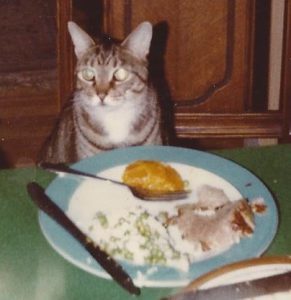
Our family cat, Mary Jane, joins the holiday table in 1981.
Maureen Milliken: I know everyone likes the traditional pies: apple, pumpkin, mince (shudder, actually I think my dad is the only one who eats that). But if you’re not already full from Brenda’s apple cheddar crisp, here’s a “pumpkin pie” recipe with an Italian twist: Pumpkin Ricotta Pie.
If you’ve never had ricotta pie, it’s a little like cheesecake, only different. Ricotta pie is a traditional Italian holiday treat, particularly at Easter, but I like to make it at Christmas, too, sometimes adding chocolate chips or other treats. But I digress. For Thanksgiving, it’s gotta be pumpkin.
This makes a fairly large pie, but if you cut it to four eggs and cut the ricotta by one-third, it’ll fit in a nine-inch pie pan. For the full recipe, use a 10-inch. I cheat and get a graham cracker crust. I know my Nonna would be rolling over in her grave, and the traditional pie crust is light, flaky and buttery, but it’s not when I make it, so I play it safe. And I might just try it with Lea’s chocolate sauce…
Here’s the recipe:
Preheat oven to 325.
6 eggs
1 cup sugar
1 tsp. vanilla extract
I 15-oz container of whole milk ricotta
Half a can of pumpkin filling
1/2 teaspoon cinnamon
1 10-inch graham cracker pie crust in pie tin (sorry Nonna)
1/3 cup brown sugar
Beat the eggs, white sugar, cinnamon and vanilla in a large mixing bowl.
Stir in the ricotta and pumpkin.
Pour the ricotta-pumpkin mixture into the pie crust. Bake at 325.
When it’s been in for about half an hour, sprinkle brown sugar on top (if the sugar is on top for too long, it will burn).
Bake a total of 50 minutes to 1 hour: a butter knife inserted into the center should come out clean.
Let cool before eating.
Mangia! (And Happy Thanksgiving!)
Save
Save
November 22, 2016
No Holiday for the Wicked
Dorothy Cannell: Happy Thanksgiving to one and all. I am, as so often happens at this  time of year, in book jail – a term coined by Kate Flora. It is where writers go when they have ignored looming deadlines until the panic stage kicks in. This being so, I won’t be cooking a lavish turkey dinner; my husband Julian and I will be eating out with friends at our favorite restaurant. I do intend, however, on giving a nod to the pilgrims by purchasing a pumpkin pie and making a pecan one. It is easy and a family favorite.
time of year, in book jail – a term coined by Kate Flora. It is where writers go when they have ignored looming deadlines until the panic stage kicks in. This being so, I won’t be cooking a lavish turkey dinner; my husband Julian and I will be eating out with friends at our favorite restaurant. I do intend, however, on giving a nod to the pilgrims by purchasing a pumpkin pie and making a pecan one. It is easy and a family favorite.
Southern Pecan Pie
Ingredients:
9-inch pie shell
4 eggs
1 cup sugar
1 cup light corn syrup
½ tablespoon flour
¼ teaspoon salt
1 teaspoon brandy (or vanilla extract)
¼ cup melted butter
2 cups pecan halves
Refrigerate 9-inch unbaked pie shell and Preheat oven to 350F
Make Filing in a medium bowl with a rotary beater, beat eggs well
Add the sugar, corn syrup, flour, salt and brandy, beat till well combined
Stir in butter and pecans, mixing well
Turn into unbaked pie shell. Bake 50 minutes, or until filling is set in the center
Cool the pie completely.
Serve with whipped cream. If desired add to the cream, 1 tablespoon sugar, grated peel of one orange, and two tablespoons brandy.

Where Dorothy is….
Now returning to my jail cell. Won’t have it to myself. I’ll have new puppy Watson tucked behind me on desk chair as I prod the keys. He’s an entire other blog, let me say only that I have renewed admiration for Sarah in the Bible who at age 800 hundred or something found herself running herself ragged on the arrival of baby Isaac.
Happy reading,
Dorothy
S. Julian had just informed me Sarah wasn’t nearly a thousand years old. Maybe not, but I’ll bet she felt like it by the time the little treasure turned one.
November 21, 2016
Setting and How It Affects Characters
Vaughn C. Hardacker here: This July my fourth thriller will be released by Skyhorse Publishing. The novel, WENDIGO, takes place entirely in the north Maine woods during the midwinter months of January and February. As I was writing the novel I soon realized that winter here in Maine’s northernmost county is as instrumental to the novel’s plot as the characters. In fact, the winter weather impacts all of my characters to a greater extent than they do one another.
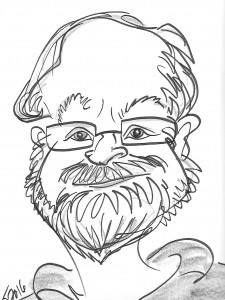
Vaughn
Anyone who has ever experienced five feet of snow on the ground and more falling along with thirty miles per hour wind (with gusts of fifty miles per hour), minus 30 degree Fahrenheit temperature, and a resulting windchill of minus 67 degrees Fahrenheit (minus 73 degrees during the aforementioned gusts) can attest to the impact it has upon them. Normal activity as mundane as taking out the trash can quickly turn into a life and death situation. If you have either lived in or spent time in THE COUNTY any time from December to April you may have experienced these climatic conditions.
“How does this make setting become a character?” The one facet required to make a novel a success is the inter-relationships between the characters. It is easy to see how personal relationships affect people, now consider the extent that the above stated conditions do. Being out in these conditions has an obvious affect on our human characters and the risk of death from hypothermia is easy to see. Being cooped up inside a house or apartment for days on end will inevitably lead to cabin fever, which often culminates in arguments and, in extreme situations, murder. If there is any minor problem with a machine, i.e. a car/truck, a snowmobile, or even an aircraft, it could easily become a major issue. I have spent many a frigid day on my back lying on ice while changing a defective starter on a car. That same starter, in all probability would have functioned in warm weather.
It isn’t hard to understand all of the above. The WENDIGO is the physical manifestation of the most evil of Anisinaubae manitous . . . in short it’s one bad assed creature and a god as well! It’s powers are strongest during the long nights of winter and it is always hungry. In fact the more it grows and the more it grows the hungrier it becomes–it is in a perpetual state of  starvation. It has a restricted diet–lets suffice to say the menu could have been used by the Donner Party. The creature itself is horrifying enough, now the setting comes into place–the deep woods in midwinter. Put yourself into this situation: It’s 3:30 P. M. and you have been ice fishing on a remote lake and notice that the sun has set. You gather up your fish tip-ups, tackle, and other paraphernalia. Once you have packed everything into the trailer you have attached to your snowmobile, you settle onto the sled and turn the key–nothing happens. Immediately you realize that you left the ignition in the on position and the battery has been drained. In itself this is enough plot to drive the story, but think about the addition of the sudden appearance of a twenty foot tall, emaciated humanoid creature with teeth like a shark, emitting thunderous roars, and can run faster than any human. It doesn’t take a Rhodes Scholar to realize this thing ain’t there to help get your sled going.
starvation. It has a restricted diet–lets suffice to say the menu could have been used by the Donner Party. The creature itself is horrifying enough, now the setting comes into place–the deep woods in midwinter. Put yourself into this situation: It’s 3:30 P. M. and you have been ice fishing on a remote lake and notice that the sun has set. You gather up your fish tip-ups, tackle, and other paraphernalia. Once you have packed everything into the trailer you have attached to your snowmobile, you settle onto the sled and turn the key–nothing happens. Immediately you realize that you left the ignition in the on position and the battery has been drained. In itself this is enough plot to drive the story, but think about the addition of the sudden appearance of a twenty foot tall, emaciated humanoid creature with teeth like a shark, emitting thunderous roars, and can run faster than any human. It doesn’t take a Rhodes Scholar to realize this thing ain’t there to help get your sled going.
All of my books thus far have been set during the summer and early fall, WENDIGO is set during the coldest and darkest time of our year. The warmth of the holidays is behind us and the long tedious days of snow, more snow, yet more snow (in 2007 we got over 200″),  and below zero temperatures. If you work in a building and you don’t have a window in your workspace you’ll begin to feel like a mushroom, waking up before the sun, driving to work in the dark, and driving home in the dark. It is not unusual to go five days without ever seeing daylight–don’t even think about the sun as cloudy days are the norm. Truthfully, you don’t like sunny days . . . in January and February a sunny sky means high pressure. High pressure means COLD; on the other hand low pressure usually means SNOW and lots of it.
and below zero temperatures. If you work in a building and you don’t have a window in your workspace you’ll begin to feel like a mushroom, waking up before the sun, driving to work in the dark, and driving home in the dark. It is not unusual to go five days without ever seeing daylight–don’t even think about the sun as cloudy days are the norm. Truthfully, you don’t like sunny days . . . in January and February a sunny sky means high pressure. High pressure means COLD; on the other hand low pressure usually means SNOW and lots of it.
So how does all this apply to your characters? Winter is a time of short days, as illustrated above, and long cold nights when everything is shrouded in snow and ice. It’s not unusual for the banks alongside the plowed roads to be ten feet or higher–an ideal place for a villain or WENDIGO to lay in wait. The only sounds you hear as you walk along an unlit rural road is the crunch of your heavy boots on the frozen ground and the wind. Snow is blowing from the top of one snowbank to the top of the one opposite and your head and shoulders are covered. The atmosphere is claustrophobic as you feel as if you are walking in an ice tunnel. Suddenly the night is split with a booming voice that sounds like thunder and a twenty foot tall beast bounds over the snowbank and lands ten feet in front of you–did I mention that it smells like grave rot?
Don’t you think that would have an affect on your character?
Nuff said.
Remember This Day
“Remember this day.” That was Paul Doiron’s advice to me the day I received the very first paperback copies of my debut novel.
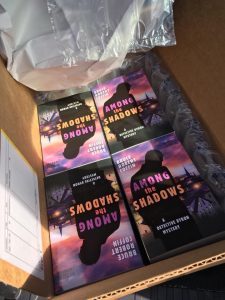 It was Saturday morning and the sun was shining and the temperature was nearing eighty as I loaded my pickup with trash, returnables, and a full recycling bin. It was getting close to eleven and I hadn’t really eaten anything you’d likely call breakfast. My plan was to hit the town dump then head back into North Windham to drop off the bottles and cans at Hannaford’s. After that I figured I’d swing by the post office, hoping for something other than bills, maybe even a bit of positive cash flow, before grabbing lunch at a fast food joint.
It was Saturday morning and the sun was shining and the temperature was nearing eighty as I loaded my pickup with trash, returnables, and a full recycling bin. It was getting close to eleven and I hadn’t really eaten anything you’d likely call breakfast. My plan was to hit the town dump then head back into North Windham to drop off the bottles and cans at Hannaford’s. After that I figured I’d swing by the post office, hoping for something other than bills, maybe even a bit of positive cash flow, before grabbing lunch at a fast food joint.
I held the door for a polite young woman then headed into the gloomy interior of the postal facility hoping for good news. Upon opening the box I discovered a new registration certificate for my wife’s car, a single piece of junk mail, and a yellow slip informing me that I needed to see the desk clerk for an item. Now I’ve seen these slips before. Usually deliveries are only kept at the counter when they’re either too big for the package bins or when all the bins are full. My mind raced. What could it be? Being early September, I surmised a pre-holiday fruitcake was probably out of the question. I hadn’t ordered anything recently and I couldn’t remember Karen telling me that she was waiting on anything. Although, maybe she had but I hadn’t been listening. Maybe she’d mentioned the purchase of some latest fashion, and instead of listening I’d glazed over like she does whenever I try and explain the inner workings of something mechanical, like the stereo remote. It was possible. The only thing I could imagine was the case of novels my publisher had promised to fulfill their contractual obligation. My pulse quickened. What was waiting for me behind the post office counter?
I dashed back to the lobby with my yellow card. Two clerks were working the counter, but the line was out to the door. My heart sank. What time does the North Windham Post Office close on Saturday? Damn. I couldn’t remember. Noon? That sounded right. I checked the time. 11:35. It was gonna be close. One by one I watched in horror as the two employees waited on my fellow Mainers. Each had a package or letters needing special handling, and wrapping, and weighing. And stamps! A collector was buying sheets. What the hell?
“Oops, hang on. That one needs another piece of packing tape,” a clerk said to one of the customers.
I was sure of it now. They were trying to kill me.
I checked my phone again. 11:40. OMG. I looked down and caught myself nervously tapping my right foot on the linoleum. I stopped.
“Yes, it has been a very dry summer, Mrs. Smith. How’s your garden?”
How’s her garden? Who cares? Jesus, if you’d just hurry up I’ll drive you to the grocery store myself and buy you all the vegetables you could ever want!
11:43.
I examined the yellow card in my hand. Read it again. I realized there was something familiar about it, this yellow card. Ah ha. I had it. The Yellow Card Man, from 11/22/63. Stephen King’s novel about the Kennedy assassination. My only hope was it didn’t foreshadow that I was about to step through some portal to the past, where I’d never find out what had been delivered.
11:46.
A customer finished at the counter and the line inched forward. I took one step. I thought again about the possibility of it being my novel. Was that even likely? I’d been in constant contact with both my editor and my publicist all week, and neither mentioned anything about the books being ready. Wouldn’t they have known? Of course they would. Maybe it wasn’t the books after all. Maybe I was being silly. How long does fruitcake keep? I looked down at my foot again. It was moving a little. I willed it to stop.
11:50.
Another satisfied customer peeled off and walked past me. One of the clerks looked at her watch.
Oh, no you don’t, I thought. Nobody leaves until I get my package.
The next customer shuffled up to the counter in slow motion.
I was due to be next. I glanced left and right, watching each transaction closely. Who would finish with their customer first? The male clerk on my left or the female on my right? People read left to right. I was betting on left. Come on, come on.
11:55.
I was beginning to feel a little like Oswald.
Finally, the customer at the window on my left was done and the male clerk waved me forward. Hot damn! I was working hard to hide my angst.
“May I help you?” the clerk asked.
“Yes,” I said, my voice cracking. “I received this slip in my mailbox.”
He took the slip from me. “What number?”
“What?” I said.
“Your box number. What is it?”
I couldn’t remember! I’d just emptied it and now I couldn’t remember the number!
I stared at the clerk. He stared back. What the hell? I couldn’t leave the line to go look. There were people behind me. They’d close before I ever made it back to the counter. I looked down at what I was holding in my hand. Mail. Ha! Correspondence from the state that had my address on it!
I recited my box number to him, fighting to stay calm. He repeated it back then walked out of sight. If this turned out to be clothes for my wife or a fruitcake, I’d be tying one on. Without question, the Yellow Card Man had reached his limit.
I watched in astonishment as the clerk rounded the corner with a large nondescript cardboard box. He had it on his hip and was struggling a bit with it’s weight. It certainly wasn’t a fruitcake. Too big for that. And clothes wouldn’t have been nearly as heavy.
Remain calm.
I watched him set the box atop the counter. A piece of paper was taped to the backside, but I couldn’t see what it said. I lowered my voice an octave trying to project cool. “Does it say who it’s from?”
He bent down to look. “Um, says it’s from HarperCollins, the publisher.”
My publisher! It was my books! Hallelujah!
“Man, I’ve been waiting for that,” I heard myself say from outside of my body.
I heard murmuring from the line behind me. Most likely someone thinking about driving me to the local bookstore to buy me some books if I’d only get moving.
“What is it?” the clerk asked.
I dropped yet another octave, moving from cool to nonchalant. “Oh, it’s just a bunch of copies of my debut novel, Among the Shadows.”
“What’s it about?” he inquired.
More murmuring.
“It’s a mystery,” I said. Smiling proudly, I lifted the box and headed for the door.
November 18, 2016
Weekend Update: November 19-20, 2016
 Next week at Maine Crime Writers, there will be posts by Bruce Coffin (Monday) Vaughn Hardacker (Tuesday), Dorothy Cannell (Wednesday), and Barb Ross (Friday), with a special Thanksgiving Day post on Thursday.
Next week at Maine Crime Writers, there will be posts by Bruce Coffin (Monday) Vaughn Hardacker (Tuesday), Dorothy Cannell (Wednesday), and Barb Ross (Friday), with a special Thanksgiving Day post on Thursday.
In the news department, here’s what’s happening with some of us who blog regularly at Maine Crime Writers:
 From Kaitlyn Dunnett/Kathy Lynn Emerson: The new Level Best anthology of New England Crime Stories, Windward, is now available as a paperback and as an ebook. It has short stories by me, my husband, and Kate Flora, among other New England writers.
From Kaitlyn Dunnett/Kathy Lynn Emerson: The new Level Best anthology of New England Crime Stories, Windward, is now available as a paperback and as an ebook. It has short stories by me, my husband, and Kate Flora, among other New England writers.
From Kate Flora: This coming Monday, Nov. 21st at 6:00 p.m., Bruce Coffin and I will be at the Kennebunk Library talking about our new police procedurals. The conversation between a seasoned cop who writes cops and a seasoned writer who writes cops should be pretty interesting. Hope we’ll see some of you there.
Coming this Thursday: A collection of recipes and stories about how real crime writers celebrate Thanksgiving.
And a reminder: This month’s MCW giveaway is Tea with the Authors, a collection of goodies to brew, goodies to eat, and goodies to read. Leave a comment on one of our posts to be eligible.
An invitation to readers of this blog: Do you have news relating to Maine, Crime, or Writing? We’d love to hear from you. Just comment below to share.
And a reminder: If your library, school, or organization is looking for a speaker, we are often available to talk about the writing process, research, where we get our ideas, and other mysteries of the business. Contact Kate Flora
The Best Medicine
Jessie: Feeling pensive.
Recently, I attended the New England Crime Bake. Every time I am in the midst of a group of writers it, not surprisingly, makes me think about what started it all in the first place. I’m not sure if all writers can pinpoint when they decided that writing was something they wished to pursue but I know exactly when I realised that I wanted to create stories to share with others.
When I was six years old I needed an emergency appendectomy. It was touch and go for a while as the toxins had spread round my system a bit. The surgeon told my parents it would be at least five days before they’d be sure I would survive. My mother was worried enough about the outcome that she slept in the hospital with me every night. She always read to me at bedtime at home and the hospital stay was no exception.
I had received a boxed set of Roald Dahl books for Christmas only a few weeks before but had not yet started to read them. My mother brought Charlie and the Chocolate Factory to the hospital and began to reading it to me. My mother is a delightful reader and snuggled up in a hopstical bed under a flickering, humming fluorescent light I was able to imagine myself swept away to a much more magical place. I was enchanted by the story and tickled pink by the humor.
By the time Violet Beauregarde was rolled off to the juicing room I laughed so hard I had ripped out most of my surgical staples. But somehow, it was worth it. Laughter really was the best medicine. By the fifth day I left the hospital, well on my way to a full recovery. I am convinced that the book and the pleasure it brought, the feeling it created that life was indeed magical, full of possibilities and not worth giving up helped move me out of the danger zone.
My health recovered but I never got over my attachment to Roald Dahl. Or books with humor and magic and well-deserved comeuppances. I knew from that point on that what I really wanted to do was to write stories of my own.
Readers, do you have a book that helped you through a difficult period? Writers, can you pinpoint when you decided on your life’s passion?
November 16, 2016
An Animal Rescue Story
Given the charged political climate and the fact that I’m still not quite recovered from the post-election catatonia I was plunged into after last Tuesday, I thought this month a little change of pace might be in order. As anyone who reads this blog has no doubt gathered by now, I’m very fond of the four-leggeds who walk among us — particularly my dog Killian, who will turn ten next month. I was running an animal rescue in Oregon when Killy’s mom arrived, very pregnant, and I’ve had the boy ever since. The following is a story I wrote for my nieces, about the unique circumstances surrounding Killian and his sister Adia’s birth and first year. Adia has sadly passed on since we wrote this, but I love the fact that her strident little voice lives on in this piece. I hope you enjoy!

Killian and Adia
“It all began on a cold day in December, when Mama was in Oregon – ” Adia begins.
“That’s not how it started,” Killian interrupts. Killian is the bigger of my two pups, but he is not the most vocal. His brow is furrowed with concern; Killian likes things to be exact.
We’re settled in the living room to tell this tale, and naturally Adia – being the more extroverted (“you mean she’s a blabbermouth,” interjects Killian, at which point a brief skirmish breaks out) of the two has decided to kick things off.
“It did so start there,” snaps Adia. “Just let me tell it.”
“It started in California,” whispers Killian to me. I nod. He has a point.
“We weren’t even born when California happened,” Adie says. “How can I tell a story we weren’t there for?”
“Mama says our dog-ma came from California,” Killian says. He sits up, becomes very serious, and begins. “Our dog-mama, Rainne, was a stray dog in the city of San Francisco. She came to the Oregon farm in a van, and she was sick with coughing and if Mama and the other rescue people hadn’t sent for her, she would’ve been killed.”
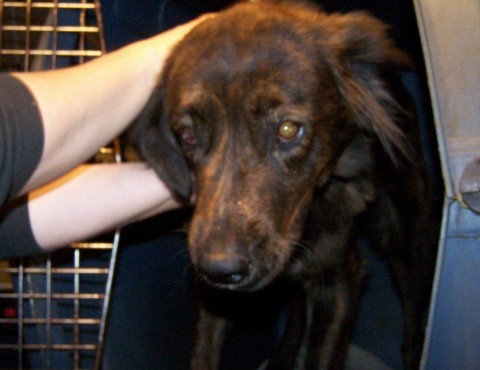
Rainne’s arrival at the rescue
“And we would’ve died, too,” says Adie. Clearly, she has come to agree that this is a better place to begin the story.
“Mama Rainne came to the rescue in Oregon with thirty other dogs,” Killian continues, “so it was very loud and crowded and scary. Those other dogs were all going to other rescues, so they could get adopted into nice homes. But our people mama met Rainney and heard her coughing, and she said,” Killy looks to me with baleful brown eyes, “What did you say, Mama?”
“She said, ‘There’s something special about this girl – let’s keep her here, just ‘til she feels better,” Adie interrupts excitedly.
Killian nods. “Yeah. That’s what Mama said.”
“But she didn’t even know we were in Mama-Rainne’s belly yet, because Rainney was so skinny. And then, we almost didn’t make it anyway, because Mama’s friend Dave took Rainney to the vet to get her fixed. And they would’ve done it – ”
“Even with babies in her belly, right, Mama?” Killian says.
“Sometimes that’s what has to be done. And that’s how it would have happened that day,” I agree gently.
“But Rainney was coughing too much, so the vet said he couldn’t do it that day. And then it was another two weeks before they could get another appointment,” Adie says.
“And by then it was too late!” Killian adds.
“And that’s when we were born,” Adia finishes triumphantly.
“Would you like to tell that story?” I ask Adia, who nods seriously (she’s never shy to tell a story) and settles on her dog bed with her paws crossed delicately in front of her.
“Then,” she says, “We got born, on a cold day in December when Mama was just getting over the flu, and she had a flight to Maine later that day for the holidays – ”
“And there was a sixteen-foot Christmas tree lodged in the front door!” Killian interrupts.
“I was getting to that part!” Adie says. “Tell him to stop interrupting.”
“There’s plenty of story for both of you,” I say. “Why don’t you tell about the day you were born, Adie, and Killy can tell us the next story.”
Adia nods her approval of this plan, and Killy sighs. He circles twice, lies down, and rests his chin heavily on his paws as Adia continues.
“Anyway,” she says, “there was a sixteen-foot Christmas tree lodged in the front door, ‘cause Dave wanted to get the biggest tree he could find, but it wouldn’t fit through the door! And Mama got up that morning to take a bath and Mama Rainne was staying in a kennel in Mama’s office in the next room, ‘cause they knew we would be coming any day. So, Mama was soaking in the tub when – ”
“She heard us crying!” Killy interrupts, his tail swishing with excitement.
“That was the best part!” Adie snaps. Then there’s another tussle that I have to break up, before each hound re-settles on their respective pillows.
“Now, where was I?” Adia asks.
“We just got borned,” Killian says.
Adie rolls her eyes at me, and continues. “Right, we were born,” she corrects Killian, “And it was Killy and me and our sisters Hannah and Tally, and our brother Connor.”
“Only we didn’t have any names yet,” Killy says.
“No,” Adia agrees. “We didn’t have any names, and we couldn’t walk, and we couldn’t even open our eyes, because we were such tiny babies. I was the littlest, and Killian was the biggest. And then, just when all five of us were born, Mama had to leave so she wouldn’t miss her plane. So, she kissed all five of our baby heads, and she kissed Mama Rainne, and said, ‘Good job, Rainney Girl. You rest now. I’ll be back in two weeks, to help you with these guys.’ And then she left.”
“We don’t remember much of what happened after that,” Killian says.
“Because we were too little,” Adie adds. “But Dave and Pop – that was Dave’s dad – pulled the tree in the front door with a whole lot of work, and they set it up in the living room and decorated it with dog toys, ‘cause there was so many of us. We ate and slept, mostly, until Mama came home.”

Pop, with the infamous 16-foot Christmas tree
“Then we opened our eyes,” Killian says. “But we waited ‘til we heard Mama’s voice. And the first thing we saw when we opened them was our people-mama, holding us.”
“That’s the first thing you saw,” Adie corrects him. “The first thing I saw was Tally, chewing on my ears. But you were in Mama’s arms the day you opened your eyes. And that’s why you’re still such a baby man when it comes to Mama.”
“I’m not a baby man,” Killy says indignantly. “I just know the people I love, and I don’t love the people I don’t know. Besides,” he lowers his voice, looking at me with an all-knowing dogged glint, “Me and Mama have a special bond. She knew I was hers, from the very start.”
It’s true, actually, that I knew from the start that Killian and I belonged together. For one thing, he cried copiously whenever I was away from him, but would settle down the moment I picked him up. There was just an energy that came from Killy, even as a pup, that spoke to me.

Me with Killian, at 4 weeks
“What about me?” Adie demands. “Didn’t I speak to you?”
“You never stopped speaking,” Killy says. Before another fight erupts, I interrupt.
“You were too busy causing trouble and fighting with your brothers and sisters to waste too much time on me in those early days,” I tell her.

Adie striding through the world, at 6 weeks.
“’Cause you were a troublemaker from the start,” Killian says.
“There was a lot of trouble to get into, though,” Adia says, rather than arguing the point. “There were goats and cows and cats and llamas and chickens and rats and… Who wouldn’t get in trouble, with all that? On our very first walk around the house, we learned all the crazy things going on in our world. Before that, we’d just been safe and secure in our kennel in Mama’s office. But then, we started meeting our pack.”
“It was a really big pack,” Killian says.
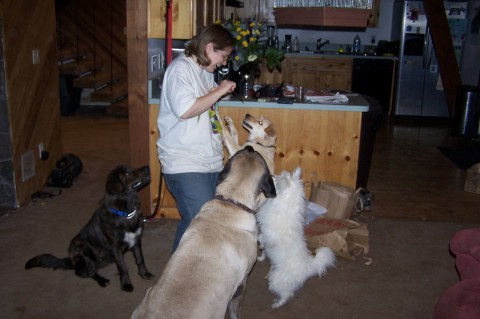
Training time, with Donna, Snowball, Spoon, and Rainne.
Adia agrees. “At first, Mama and Dave were careful about who they introduced us to, ‘cause some of the animals there didn’t like puppies so much. We met Grandma Spoon first – ”
“We loved Grandma Spoon,” Killian says, his eyes taking on a distant cast.
“We did,” Adie says. “Grandma Spoon was an English – ” she looks at me and whispers, “What was she, Mama?”
“Spoony was a prize-winning English mastiff who had been a gift to Dave,” I say.

Marmalade the Cat checks out a snoozing Spoon.
“Yeah,” Adie says. “That. She’d been a mama before, so she knew just what to do to keep puppies in line. Everybody loved her – even kittens. She taught Rainney to be a good mom, since Mama says Rainney was practically a puppy herself.”
“Then we met all our aunts and uncles,” Killian says. “Buck and Linus and Cheesecake and Tiger.”
“And Donna,” says Adia. “And Louie!”
“Some of them were afraid of us – especially Louie,” Killian says. “Even though he looked big and tough, he was gentle as a kitten. Me and Adie and the other pups would chase him and chase him, and he would just hide. Then when he laid down, we’d find him and cuddle up next to him like he was our mama.”

King Louie
“And we met the goats, too,” Killian continues. “We’d have picnics with the goats.”
“On the farm,” Adie explains, “There was a house for the people and for the dogs, and there was a barn, and there was a cat house.”
“And lots of land,” Killian adds. “Tell them how much land there was, Mama.”
The farm was set on sixteen acres in Estacada, Oregon – about thirty miles outside Portland. We had a pasture and barn for the farm animals, and a three thousand-square-foot home that Dave and I shared with his eighty-five-year-old father and about twenty dogs, four degus, a parakeet, a Moluccan cockatiel, and a bathroom full of kittens. The cat house was a huge garage that held about thirty rescued cats, most of whom had come from a high-kill shelter down in California.
“It was a lot of space,” Adie concludes. “And once we were big enough, Mama and Dave would take us on picnics. They’d carry all five of us pups out into the field with some lunch and we’d play in the Oregon sunshine, and wrestle with each other, and explore.”
“And sometimes Butterfly the goat would come and say hello,” Killian says. “She was an old lady goat, and she loved to nuzzle Mama and chase after us pups.”

Tally vs Butterfly
“We loved our picnics,” Adie says.
“Except for one day, when the dinosaur tried to get us,” Killian says. “That wasn’t a very fun picnic.”
“She wasn’t really a dinosaur, though,” Adie says. “And she didn’t mean any harm – right, Mama?”
I shake my head.
Lucy just looked like a dinosaur, but in fact she was an ancient, tumor-ridden bulldog/Sharpe mix that Dave had rescued from euthanasia in a shelter back in California. She’d been a breeder for years, until she couldn’t handle another batch of pups – at which point, she’d literally been tossed out of a moving car, not far from the Merced County shelter. Dave brought her home and entrusted her care to Pop.
The old girl was too decrepit to move much, but she always got a spark under her when she smelled babies that she thought might be in need of mothering.

Lucy
“That day when we were out in the field,” Adie picks up the story, “Old Lucy hadn’t been farther than a few feet from the house in months. But when she heard puppies crying, she came plodding out to the field to find us.”
“Mama got real upset,” Killian says. “By that time, Rainney’d had enough of us, and so she wasn’t around much – we only had our people-ma to take care of us. She said, ‘Go on home, Lucy – these pups already have a mama.’ And she picked us up and moved us farther into the field. But pretty soon, along came Lucy, plodding along to try and rescue us. She got Tally in her mouth and started to carry her back to the house, and Mama had to go and save her.”
“Tally cried and cried,” Adie says. “She was awfully scared of Lucy.”
Not everyone was scared of Lucy, though. We started out keeping a parcel of sick kittens in the bathroom adjacent to Dave and my bedroom. When it became apparent that it wasn’t wise to have wild kittens at large in the middle of the night when one needed to use the facilities, we transferred them to a room that Dave painted a vibrant violet. We added a Buddha, a mattress, some plants, and a fountain. Dave called it our Tranquility Room – the perfect spot for kittens to grow into cats. Unfortunately, Spoony decided that the mattress in the Tranquility Room was the perfect spot for her, and the fountain ideal to slake the thirst of a hundred-and-fifty-pound English mastiff. She would periodically nose her way into the room – which wouldn’t have been a problem, had we not shared the house with several not-so-kitten-friendly dogs.
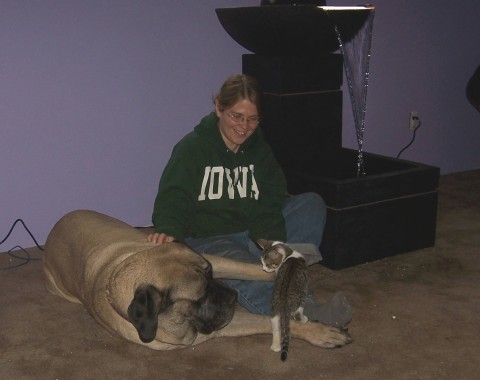
Spoon, Spike the kitten, and me in the tranquility room.
One day, Spoony managed to get back into the Tranquility Room while Dave and I were out shopping. When we returned, we found kittens – mercifully unharmed – scattered throughout the house (the non-kitten-friendly dogs were all kenneled when we were gone). Unfortunately, one kitten — a little tabby named Taz — was nowhere to be found. We’d turned the house upside down when Pop emerged from his room.
“You missing someone?” he asked. When we told him that we were, indeed, one kitten short, he gestured us into his room.
There, sleeping cozily on top of Lucy’s gargantuan belly, was Taz.
“She brought him in while I was washing up,” Pop said. “I didn’t know where you wanted him, and he didn’t seem too concerned, so I just left ‘em.”
We never again doubted Lucy’s good intentions when it came to the babies she so desperately seemed to want to mother.
◊◊◊◊◊
By now it’s dusk. We’ve had our dinner and our walk, and Killian and Adia have stopped their spatting and are curled up together on the day-bed. I ask what story we should tell next.
“The move, of course,” Adia says, as if I’m a little daft.
“Yeah – the move,” Killian agrees. “That’s a good story. We can tell about getting the bus and how Dave ripped out all the seats so we could fit our fridge, and what happened to the cows, and the school and – ”
“You’ll spoil it if you tell it all now,” Adie says indignantly. “Later, we’ll tell about the move.”
I agree: the move is the next story.
Jen Blood is author of the USA Today-bestselling Erin Solomon mysteries and the newly released The Darkest Thread, the first novel in the Flint K-9 Search and Rescue Mysteries. You can learn more about Jen and her work at www.jenblood.com.
November 15, 2016
Crime Bake Report
Brenda Buchanan here, two days after returning from the ‘Bake, grateful I had the opportunity to spend last weekend hanging out with a bunch of my crime writing pals.
For the uninitiated, the ‘Bake is shorthand for the New England Crime Bake, an annual crime writing conference held outside of Boston. This was my 8th ‘Bake and the timing could not have been better. Last week was a difficult one for many of us. It was good to take a break from all the election-related stress and talk about murder.
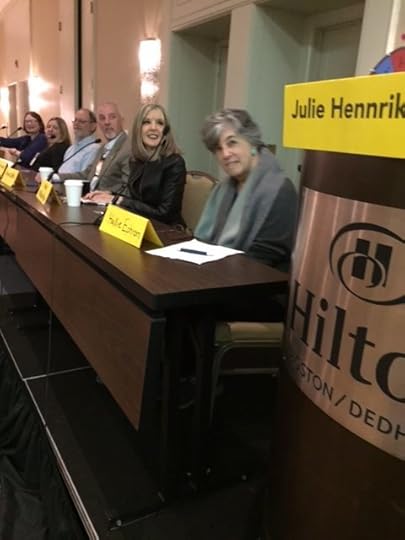
Authors of cozies, police procedurals and thrillers competed during a Wheel of Fortune inspired panel at the New England Crime Bake
The ‘Bake is solidarity in action. Several hundred people take over a suburban Hilton for the weekend, all of whom know first-hand the struggles of the lonely crime writer.
To construct plots that work. Characters who captivate. Prose that sings.
We celebrate our shared obsession at master classes with titles like Setting: It’s a Sexy Character, panel discussions called Our Big Guns and How They Got There and workshops on Traveling in Packs: Writers Band Together for Promotion.
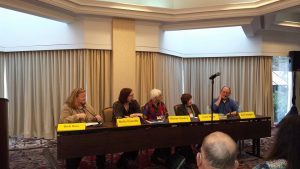
On Sunday morning retired Maine game warden Roger Guay presented Canine CSI, a fascinating talk about his work with canine partners to solve crimes and find missing persons.
I believe his session prompted a huge run at the book table on A Good Man With A Dog, the memoir he wrote with Kate Flora. Roger is one heck of a story teller.
Readers of this post considering attending the ‘Bake or a similar event should be aware there are two kinds of gatherings. Some (Bouchercon, Malice Domestic) have programming aimed at readers, and they’re a blast.
Writer-focused conferences like the ‘Bake offer valuable lessons in craft and professionalism as well as the opportunity to meet and pitch agents and editors. But take my word for it, they also involve plenty of fun.
Imagine, if you will, people dressed like lumberjacks getting down to Little Red Corvette.
Enough said.
November 14, 2016
Write What You Want To Know
One of the basic rules for authors is to “write what you know.”
That rule makes sense. I often write about the State of Maine, which I know and love. In my Shadows Antique Print Mystery series my protagonist, Maggie Summer, is an antique dealer, as I was for more than thirty years. In the latest in that series (Shadows on a Morning in Maine,), Maggie, a single adult, adopts an older child – something I did four times.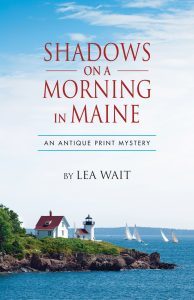
So – yes – I’ve written what I know.
But I’ve also written about a lot of things I wanted to know.
I asked myself … what if ….
Parents of a man who’d watched their son die of AIDS decided it would be a mercy to kill others with that disease so they would avoid suffering? (Shadows at the Fair)
An elderly woman with Alzheimer’s started talking about the secrets she’d kept for the past eighty years? (Shadows on a Maine Christmas)
A family that defined itself as descendants of a famous artist discovers an 1890 diary that tears that assumption apart? (Shadows of a Down East Summer)
A woman disappears when her daughter is ten, leaving the girl to believe she’s been deserted. And then, seventeen years later, the mother’s body is found? (Twisted Threads)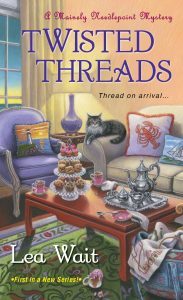
A traveling girl spiritualist draws crowds during the first two weeks of the Civil War, and then the two teenage boys who publish the local newspaper decide to prove she’s a fake? (Uncertain Glory)
A boy loses his leg in an 1819 farm accident, but refuses to accept that his life is over? (Wintering Well)
And, in my latest book, Dangling by a Thread, what if a man isolates himself on an island off the coast of Maine that has no water, electricity or heat … and refuses to leave?
For all these books, research and imagination were key ingredients to creating credible characters and plots.
The idea for Jesse Lockhart, the hermit in Dangling by a Thread, came from a man I’d seen when I was ten years old. Townspeople called him “The 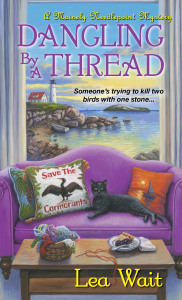 Character.” I didn’t know his real name until decades later. Like Jesse, he lived on an isolated island off the coast of Maine. Like Jesse, he rowed into town occasionally for food and other supplies. I never knew that man’s story – but, at ten years old, when I first saw him, I imagined what it might be.
Character.” I didn’t know his real name until decades later. Like Jesse, he lived on an isolated island off the coast of Maine. Like Jesse, he rowed into town occasionally for food and other supplies. I never knew that man’s story – but, at ten years old, when I first saw him, I imagined what it might be.
And when I imaged Jesse Lockhart, I gave him reasons – reasons to choose to be alone, and reasons to isolate himself on an island.
Jesse is a fictional character and, no, I don’t know what it’s like to live alone without modern conveniences. But I knew people had done it … still do, in some places. Imagination plus research created Jesse.
My readers will let me know whether I succeeded in bringing him to life.
November 13, 2016
The Class With All The Smart Girls
Kaitlyn Dunnett/Kathy Lynn Emerson here. I graduated from high school in Liberty, New York in 1965. Although I didn’t know this until many years later, we were known by some as “the class with all the smart girls.” I did know that nine out of our class’s academic Top Ten were girls because I was one of them.
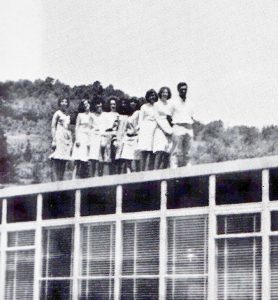
In 1965, the concept of “girl power” was still a long way off. The lyrics “I am woman/hear me roar” was in the future, too. Females could not get a credit card (or a bank loan) in their own names. They needed a man to co-sign. That didn’t change until 1974. In 1965, abortions were illegal and extremely dangerous due to the unsanitary conditions under which they were performed. That didn’t change until 1973. In 1965, “the pill” was available for birth control, but not to all women in all states, even if they were married. A woman could not attend Yale or Princeton until 1969, or matriculate at Harvard until 1977. She couldn’t practice law in every state until 1971 or be admitted to astronaut training until 1978. She could not marry and keep her job if she was a stewardess for Pan American Airlines. She could be fired simply for being pregnant until 1978 and had no legal recourse if she was subjected to sexual harassment in the workplace until 1977. No woman could legally run in the Boston Marathon until 1972. Women couldn’t get a no-fault divorce until 1969 and in some states women could not serve on a jury until 1973. In 1965, there was just one woman governor and only two females were U. S. Senators.
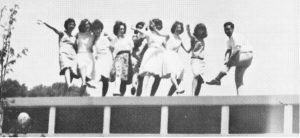
Was I aware of any of that at seventeen? Not really. Like most teenagers, I was pretty self-centered. I was also appallingly naïve. Fortunately for me, although I didn’t appreciate it at the time, I was blessed with a mother who expected me to excel. I knew from an early age that I would go to college, even though neither of my parents had done so. I was also encouraged to think for myself. I went against the advice of our school guidance counselor, “Moose” Gerber, who told me that I shouldn’t consider applying anywhere but Albany State. Instead, I applied to William and Mary, where I made the wait list, Oneonta State for a “security school” and Bates College in Lewiston, Maine, where I was admitted under early acceptance. I also considered applying to Randolph Macon Women’s College because author Pearl S. Buck had graduated from there.
But to return to the top ten. We were in the same classes. Overlapping groups of us went to movies together, ate together at lunchtime, and participated the yearbook, the school newspaper, Senior Star, and productions of My Sister Eileen, Ah, Wilderness, and The Music Man. We went to each others’ pajama parties (at which, with great daring, we made crank calls to teachers). I don’t remember that we talked much about career goals in any of those settings. Feminism, women’s lib, and bra burning were still a few years away. On the other hand, I’m pretty sure we all shared the expectation that we would go to college and have a career afterward. We weren’t just going for four years of higher education to get our MRS degree.
For many years, I was out of touch with the other eight “smart girls.” Sara and Glenna are no longer with us, but thanks to reunions and Facebook a few of the old friendships have been renewed. To the best of my knowledge, everyone but me has retired, but at the twenty year mark Leslie, Cheryl, and Glenna were teachers and Judy had traded in that career in for a new one as a lawyer. Sara and Wendy were in banking. Mary Lou was in marketing. Eileen was a speech-language pathologist. Then there was the oddball—me. By then I’d taught at three levels—first grade, community college, and junior high, been a library assistant at the University of Maine at Farmington, and then taken the plunge to become a full-time writer. Nobody ever told me I couldn’t do any of those things. Then again, I wasn’t trying to break into a profession traditionally dominated by men.
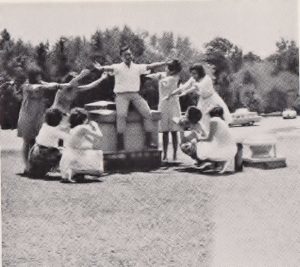
Speaking of men, what about the one boy in the mix? As you can see from the photo, taken from our yearbook, in 1965 we thought it would be funny to pose as his devoted worshippers. Somehow, I don’t think we’d include this in the shoot if we took the photos today. Then again . . . . Michael, I should add, perhaps seriously and perhaps not, said that his goal was to become the first Jewish president of the United States. Twenty years out, he was an attorney specializing in international law. I don’t know what he’s doing now.
Women born around 1947 have seen the world change for the better and a lot of them played vital roles in making that happen. I look back fifty-one years with great fondness. That nostalgia is even playing a major part in the new mystery series I’m working on for a 2018 launch.
1965 came at the very beginning of a new era for women. A few years later, they used to say “You’ve come a long way, baby!” and it was true, but not everyone was happy when the glass ceiling got another crack in it. What we used to call the “male chauvinist pig” still exists.
When you get right down to it, calling us “smart girls” wasn’t really a compliment back in 1965. There are people out there today, some of them in positions of power, who would like to take things back to the way they were before 1965, when women were actively discouraged from going to college, working outside the home, or even thinking for themselves. Fond as my memories are, I wouldn’t want to be forced to live in the world of 1965 again. It would be almost as stifling as being transported back to the 1580s, the time period in which my Mistress Jaffrey Mysteries are set.
P.S. In case you’re wondering, the pictures in this blog were taken on the roof of the school. We had no business being up there, but there was this ladder . . .
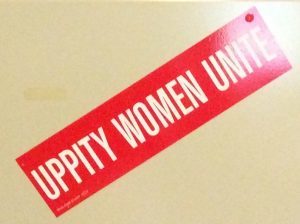
Kathy Lynn Emerson/Kaitlyn Dunnett is the author of over fifty books written under several names. She won the Agatha Award for best mystery nonfiction of 2008 for How to Write Killer Historical Mysteries and was an Agatha Award finalist in 2015 in the best mystery short story category for “The Blessing Witch.” Currently she writes the contemporary Liss MacCrimmon Mysteries (Kilt at the Highland Games) as Kaitlyn and the historical Mistress Jaffrey Mysteries (Murder in a Cornish Alehouse ~ UK in December 2016; US in April 2017) as Kathy. The latter series is a spin-off from her earlier “Face Down” series and is set in Elizabethan England. In addition, as Kaitlyn, she is working on a new series, this one featuring a sixty-nine year old woman who returns to her old home town after fifty years away. Kathy’s websites are www.KaitlynDunnett.com and www.KathyLynnEmerson.com
Lea Wait's Blog
- Lea Wait's profile
- 509 followers






